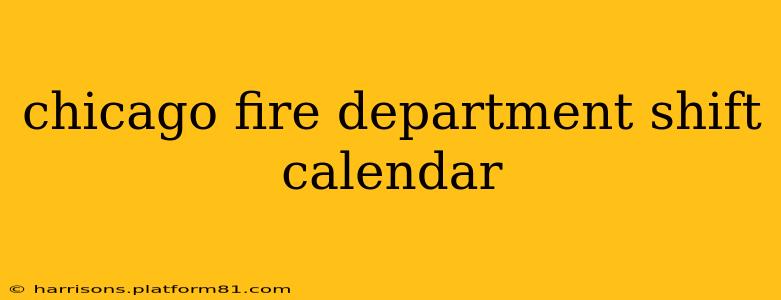The Chicago Fire Department (CFD) operates on a complex shift system designed to ensure 24/7 coverage across the city. Understanding this system is crucial for firefighters, residents, and anyone interested in the inner workings of this vital public service. This guide delves into the intricacies of the CFD shift calendar, addressing common questions and providing valuable insights.
What is the CFD's Shift Structure?
The CFD utilizes a system of rotating shifts, ensuring equitable distribution of work and rest periods among its personnel. While the exact schedule specifics might vary slightly between stations and over time due to staffing needs and other operational factors, the core principles remain consistent. Generally, the CFD employs a 24-hour on-duty/48-hour off-duty cycle, though variations in this cycle can occur depending on individual station needs and departmental directives. This means firefighters typically work a full 24-hour shift followed by a 48-hour break before their next shift. This cycle is then repeated, creating a continuous rotation of shifts throughout the year. This system ensures consistent coverage and allows for adequate rest and recovery for the personnel.
How Does the CFD Schedule Shifts for its Firefighters?
The CFD's scheduling process involves a sophisticated algorithm and manual adjustments to account for various operational factors. The department considers factors like:
- Personnel availability: Individual firefighter requests for time off, vacations, and other absences are factored into the scheduling process.
- Station staffing needs: The CFD balances staffing levels across all stations to ensure adequate coverage across the city, particularly during peak demand periods.
- Training and other commitments: Scheduling accommodates necessary training, professional development, and other commitments that may pull firefighters away from their regular duties.
The precise details of the scheduling system, however, are not publicly available to protect operational efficiency and personnel privacy.
Are CFD Shift Calendars Publicly Available?
No, specific, detailed CFD shift calendars for individual stations are not publicly accessible. This is primarily due to security concerns. Releasing this information could compromise the safety and security of firefighters and stations, potentially making them more vulnerable to targeted attacks or other threats.
How Can I Find Out About Specific CFD Station Staffing Levels?
While precise shift calendars are not available, general information about station coverage and staffing may be available through Freedom of Information Act (FOIA) requests to the CFD. However, the response time and the amount of information released will depend on the specifics of the request and the department's policies.
What are the Typical Working Conditions for CFD Firefighters?
CFD firefighters face demanding and unpredictable working conditions. Their work involves high levels of physical exertion, exposure to hazardous materials, and stressful emergency situations. They require significant training and possess exceptional physical and mental resilience. The 24-hour shift structure, while ensuring continuous coverage, also presents unique challenges related to sleep deprivation and work-life balance.
How Does the CFD Manage Overtime?
Overtime accrual within the CFD is a complex process governed by union contracts and departmental regulations. Situations like unexpected absences, equipment malfunctions, or major incidents can lead to overtime opportunities for firefighters. Specific details concerning overtime management are generally not publicly disclosed.
This guide provides a general overview of the CFD shift calendar and related aspects. Remember, the specific details of scheduling and operational procedures are internal matters to the CFD and are not made public for security reasons. For precise information on any particular aspect, a direct inquiry to the CFD or appropriate channels would be necessary.
